I have freshwater Angelfish for 4 to 5 years now and they look amazing in my aquarium.
They are actually the center of attraction of my aquarium.
My Angelfish are about 6 inches long and I was wondering how big can they get.
And this is the question many beginners ask as they are confused about the tank size to keep Angelfish.
No worries…
In this article, I am going to answer all of your questions.
Angelfish can get about 6-8 inches long and 8-12 inches tall.
If you take really good care of it i.e. if you provided the ideal environment and food then it can grow bigger than that.
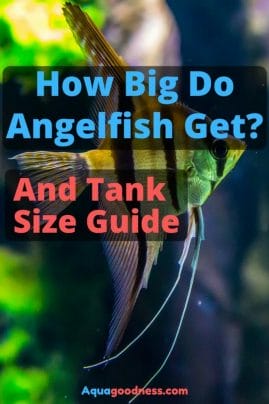
Table of Contents
How big do Angelfish get in the wild?
Angelfish can get up to 12 inches tall and 10 inches long in wild.
In the wild, it will get a lot of space to swim around and it will also get natural food which contributes to its bigger growth.
How big do Angelfish get in captivity?
Generally, Angelfish can get up to 6-8 inches tall in captivity.
If you take very good care of it i.e. if you provide it a lot of space to swim say a 55-gallon tank. Keep up with the water changes and provide it a good quality food then it may grow up to 10 inches tall, though it is very rare.
How long do Angelfish live?
If you take good care of Angelfish tank then it can live for 10 to 12 years in your fish tank.
Angelfish reach their adulthood in about one and a half years.
So it doesn’t take a lot of time to grow to its full size.
So if this is going to be your first aquarium or you are planning to buy a new tank then I highly recommend you to get at least a 29-gallon tank.
It will provide a lot of space for your Angelfish.
Besides, there there are some benefits of a large fish tank like you will have to do water changes less frequently, etc.
Angelfish tank size guide
If you are wondering what size tank do I need to keep freshwater Angelfish then there are a lot of factors that come into play while deciding the tank size.
These factors include:
- How many plants do you want to keep in your aquarium?
- If you are planning for a heavily planted tank then you will need to get a bigger tank.
- How often you are willing to do the water changes?
- If you are willing to do more water changes on a weekly basis say 3-4 times then you can keep Angelfish even in a 10-gallon tank.
- What kind of filter you are going to use?
- The filter also plays an important role while deciding the tank size. If you are going to use a powerful canister filter then you can keep Angelfish in a smaller tank.
- And how many and what other tank mates you are going to put with your Angelfish?
- Tankmates also play a crucial part while deciding tank size. If you keep messy fish or a lot of fish with your Angelfish then you’ll need a bigger tank.
Now, I know, it may look pretty overwhelming to decide the correct tank size.
So the general rule of thumb you can follow is to get a 29-gallon tank for keeping 2 Angelfish.
A 29-gallon tank is big enough for your Angelfish.
And it will also let you add plants and other smaller variety of fish without having you to do frequent water changes.
If you change 40-50% water once in a week then it will bee just fine.
Now if you are willing to do water changes more frequently then you can include more than two Angelfish in the tank.
Or you can stock the tank with more other fish varieties as tank mates for your Angelfish.
A simple method to calculate tank size for your Angelfish
A simple method to figure out what size of fish tank you will need for Angelfish is as follows.
This method is very straight forward. The method is one gallon per inch.
You can choose the tank according to the size of the Angelfish you want.
As angelfish grow more taller than longer so you should take the height of Angelfish into consideration while using this rule than the length of it.
But the flow in this rule is that it doesn’t consider the length of the fish.
As well as it also doesn’t consider the other things that you put into your aquarium like gravel, plants and other ornaments which also takes a lot of space of your aquarium.
So to make the calculations simple we can add 10 gallons more for all this stuff that occupies the space of your aquarium.
Now let’s take an example
If you chose 3-inch tall angelfish then there is 3 gallons for the 3-inch tall Angelfish plus 10 gallons for other stuff.
So in total, you have to get 13 gallon tank for 3 inch angelfish.
And for two 3 inch each angelfish you will have to get 6 gallon tank for the total 6 inch fish and extra 20 gallons for other stuff like plant, gravel, and decorations.
So in total you will have to get 26 gallon tank for two angelfish.
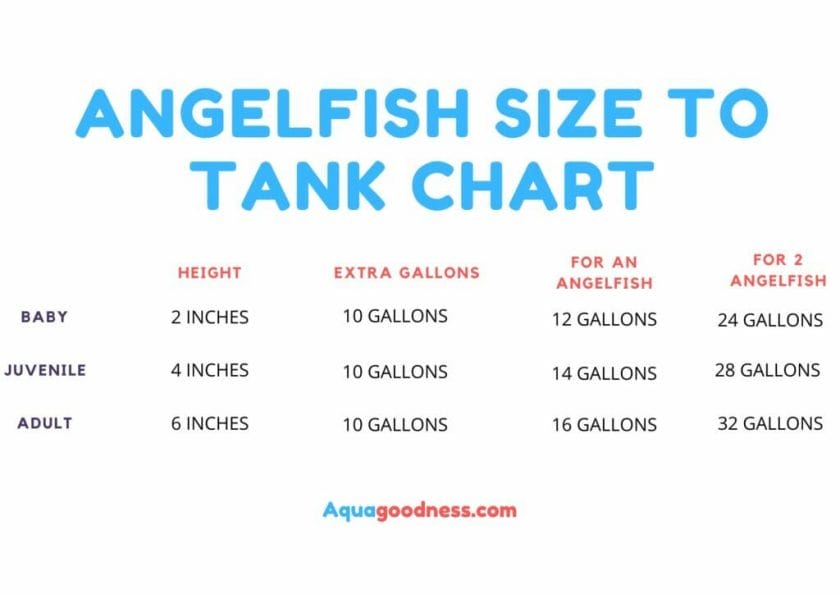
Angelfish Tankmates
There are a couple of things you should keep in mind while selecting tank mates for your freshwater Angelfish.
The first thing is you should select the fish that are large enough so that they will not fit into the mouth of your Angelfish.
If you keep small size fish, for example, Neon tetra or small Cherry barbs then Angelfish can eat them easily.
Angelfish is a cichlid and they are known as territorial. But every fish has its personality.
Some Angelfish will not eat other fish even if they can fit into their mouth and some will eat them.
So it really depends on the individual fish but to stay on the safer side, you should avoid keeping small fish that can easily fit into the mouth of your Angelfish.
The second thing you should keep in mind while selecting tank mates is the fish should not be fin nipper.
Angelfish have long fins and they are also not very quick to swim so fin nippers can really give them a hard time.
So you should avoid keeping fin nippers with your angelfish.
Again, every fish has a different personality. Some people have kept fin nippers like Tiger barbs with their Angelfish successfully.
But to stay on the safer side, you should avoid the fish varieties that are known to be fin nippers.
Pro tip
If you want to keep small-sized fish that can fit into the mouth of your Angelfish.
And/or if you really want to keep some fish that are known fin nippers then a large heavily planted tank can increase your chances of success.
As large heavily planted tank will provide a lot of hiding places to fish.
Some good examples of Angelfish tankmates
1. Placos
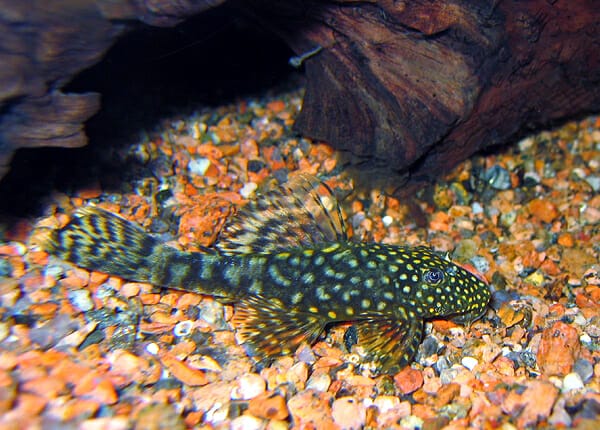
Image by Pia Helminen under CC BY-SA 3.0
Plecos are compatible with a lot of freshwater aquarium fish because they can tolerate a wide range of water parameters.
And they usually don’t botherAngelfish.
They are also very easy to care for.
All they want is some aquarium plants and algae to feed on.
As they are algae eaters, they will also help to keep your aquarium tank clean.
Once they get bigger, you should start providing them some algae wafers for their proper growth.
2. Dwarf Red Gourami
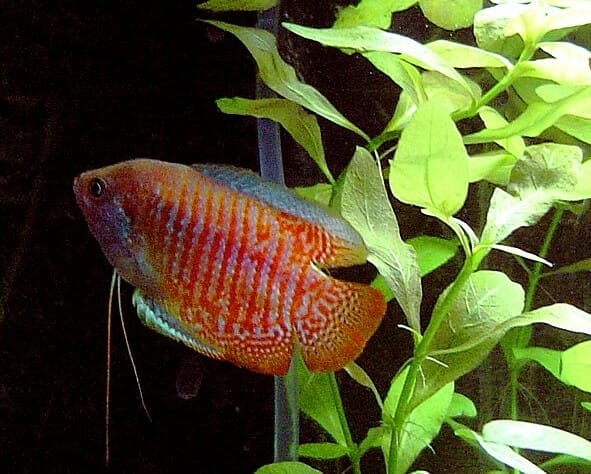
Image source under CC BY-SA 4.0
Dwarf red gourami is another good tank mate to keep in an Angelfish tank.
I am just including Red gourami on purpose.
Because there are some other types of Gouramis like Gold and Blue Gouramis that are a little bit more aggressive, so you should avoid keeping them with Angelfish.
3. Platy fish
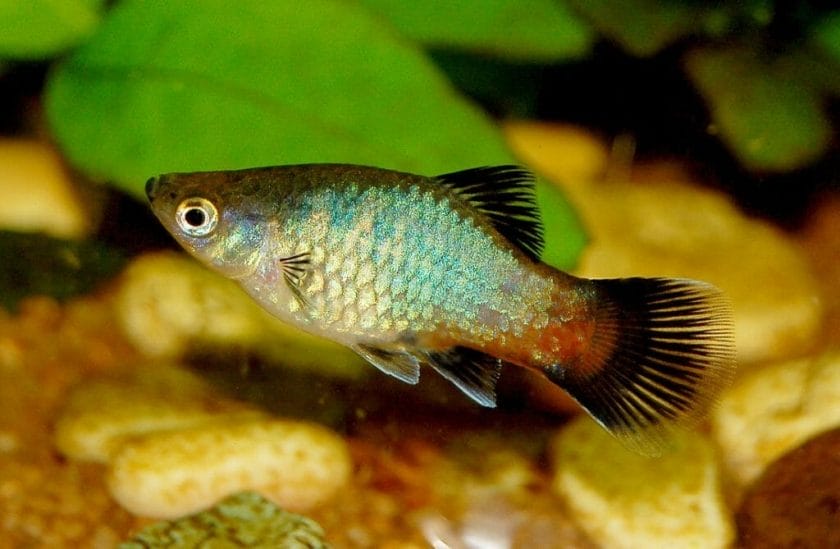
Image by Marrabbio2 under CC BY-SA 3.0
Platy fish is a very good example of an ideal tank mate for Angelfish.
Platy fish are very peaceful and they will not bother your fish.
Also, they are not too small to fit into the mouth of your Angelfish.
4. Catfish
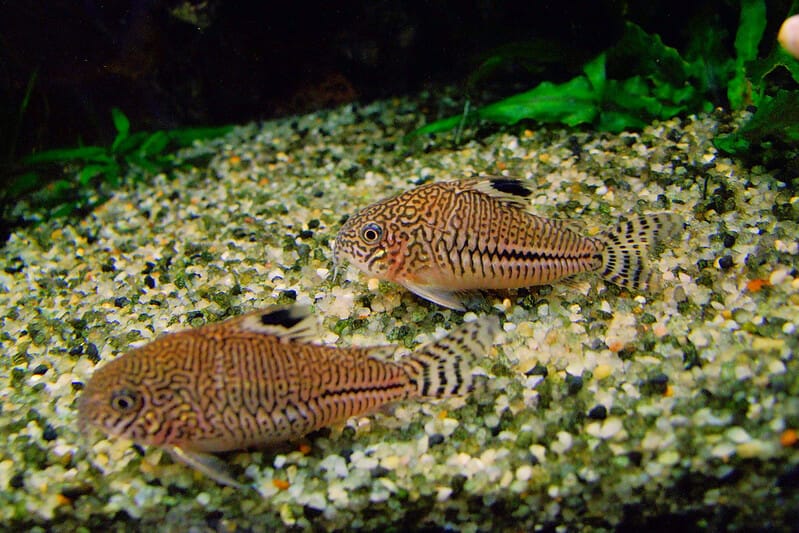
Image source under CC BY 2.0
You can keep different varieties of Catfish with your Angelfish.
Catfish are bottom dweller and they spend most of their time searching for food near the substrate of the aquarium so they will not bother your fish.
Besides, they are big enough to not fit into the mouth of your Angelfish.
5. Tetras
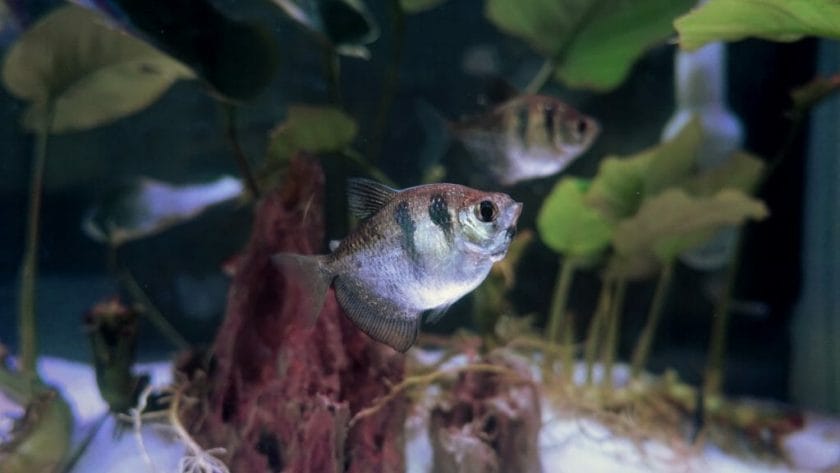
You can also keep different types of Tetra like Black skirt Tetra and Glowing Tetra with your Angelfish.
But you have to be very cautious while keeping them.
Some tetra fish may nip on the fins of your Angelfish.
So you will have to keep an eye on them regularly.
Also, you should not keep the Tetras that are very small in size like Neon tetra because it can easily fit into the mouth of your Angelfish.
Angelfish food guide for faster growth
Angelfish live for about 10 years and it usually grows up to 6 inches tall.
It reaches its full size in about 1.5 years or 17 to 18 months.
How big Angelfish will grow and how fast it will grow is really dependent on the environment and the food you provide.
In this section, we are going to talk about what kind of food you should provide and everything you need to know about feeding your Angelfish.
What kind of food is best for Angelfish?
Angelfish requires a high protein diet.
At the same time, Angelfish are omnivorous so it requires veggies as well for its proper growth.
There are different types of food you can feed to your it like frozen food, live food, flake food, etc.
Frozen food
Frozen food is a very convenient food. The best part about this food is that it doesn’t have any risk of transferring parasite into your fish tank.
Frozen food includes frozen Brine shrimp, bloodworms and Mysis shrimp.
The drawback of Frozen food is, it contains a bit fewer nutrients than live food.
Live food
There are various types of live foods that are protein-rich.
Examples of these kinds of foods include bloodworms, brine shrimp and other such small creatures.
Live food is the most nutritious food you can feed to your angelfish.
But the drawback of live food is that it may contain some parasite that may get transferred into your tank.
But you can easily avoid this problem if you buy live food from a reputable aquarium shop.
Flake food
Flake food is another convenient food and it is usually the most affordable food.
While selecting flake food for your Angelfish make sure that the first ingredient that the food contains is either protein or fish meal.
Vegetables
As mentioned earlier, Angelfish is omnivorous so it can eat both a vegetarian diet and a non-vegetarian diet.
You can easily fulfill its non-vegetarian diet by feeding it live or Brine shrimp Bloodworms, Mysis shrimp, etc.
But to fulfill its vegetarian diet, you can also feed boiled peas, zucchini, cucumber, etc.
How often should I feed my Angelfish?
Ideally, you should feed twice a day and you should feed it the food that it can consume within 3 minutes.
You should also be cautious not to overfeed your fish.
Again, you should only feed the amount of food your Angelfish can consume within 3 minutes.
How to choose an Angelfish?
There are a few things you should keep in mind while choosing Angelfish for your aquarium.
1. The first thing you should look is that you should not choose a full-grown angelfish.
Because half the fun of having an aquarium is to see your fish grow.
2. The second thing you should keep in mind is that you should watch the head of the Angelfish closely.
And you should choose the one which has a thicker face.
Because it is a sign of healthy Angelfish.
3. The third thing you should look at is that you should closely look into the eyes of the Angelfish and avoid choosing the one which has a cloudy eye.
Usually, it is caused due to disease so you don’t want this kind of fish in your aquarium.
Now the disease can be cured but if you are a beginner then I suggest you go for a healthy Angelfish.
Once you chose healthy fish for aquarium then it will be a lot easier for you to take care of it.
With that out of the way, let’s look at some Angelfish care tips.
Angelfish care tips
Angelfish is a very hardy fish and it can adapt to the environment so it is not that difficult to keep in your aquarium.
You can easily keep it even if you are a beginner.
Tank size
Angelfish can grow pretty big!
Though it is not the biggest freshwater aquarium fish, it can grow up to 6 to 8 inches long and up to 10 inches tall.
So ideally, you should use a 29-gallon tank for two angelfish.
You can keep more than two Angelfish in a 29-gallon tank or you can also keep it in a tank which is less than 29 gallons say 10 to 20 gallons.
But then you will have to do water change more frequently that could even be every other day.
So if you are a beginner then I highly suggest you choose a larger tank of 29 gallons for your angelfish because it will make your life a lot easier.
Food
Angelfish require a high protein diet.
So ideally, you should feed it live food which is protein-packed like live bloodworms, shrimps, etc.
While choosing live food just make sure to buy the food from a reputable aquarium shop.
Because live food also carries the risk of transferring parasite in your aquarium.
You can easily avoid the risk of transferring parasite into your aquarium by feeding Frozen food like frozen bloodworms and brine shrimp.
As Angelfish is omnivorous you should also feed it vegetables like boiled peas, zucchini, and lettuce,1-2 times per week.
Tankmates
Angelfish is not very aggressive and it can do well with many freshwater aquarium fish.
It is also a very good fish to keep in a community tank.
But while choosing tank mates for Angelfish just keep in mind a couple of things.
- The first thing is that the fish should not be smaller than the size of the mouth of your angelfish.
- And the second thing is that you should avoid keeping fin nipper fish.
Ideal water parameters
As mentioned earlier, angelfish are very adaptable fish, and they can tolerate a wide range of water parameters.
That being said, the ideal temperature for Angelfish is between 70-84 degree Fahrenheit.
Its water hardness tolerance range is between 5 to 13 DH and its pH tolerance range is between 6 to 7.5.
FAQ
Do Angelfish eat other fish?
Yes, Angelfish can eat other fish if they are smaller than the size of their mouth.
So you should avoid keeping fish that are small in size like Neon tetra and fry of other fish with it.
Do Angelfish recognize their owners?
Yes, Angelfish are smart enough to recognize their owner.
Conclusion
So Angelfish can get up to 8 inches long and 12 inches tall.
How tall it will get is really dependent on the environment and food it gets.
So, you should try to maintain the ideal environment and provide protein-rich food to your Angelfish for its proper growth.
I hope you found this article helpful.
If you do, please share it.
As always happy fish keeping!